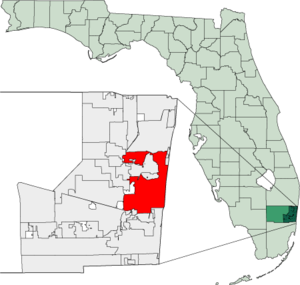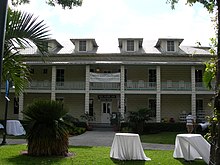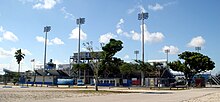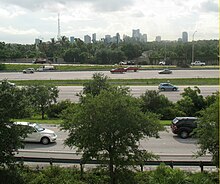Fort Lauderdale
| Fort Lauderdale | |
|---|---|
| Nickname : Venice of America | |
 Fort Lauderdale skyline |
|
| County and state location | |
| Basic data | |
| Foundation : | March 27, 1911 |
| State : | United States |
| State : | Florida |
| County : | Broward County |
| Coordinates : | 26 ° 8 ′ N , 80 ° 8 ′ W |
| Time zone : | Eastern ( UTC − 5 / −4 ) |
|
Inhabitants : - Metropolitan Area : |
178,752 (as of July 1, 2016 ) 5,564,635 (as of 2010) |
| Population density : | 0 inhabitants per km 2 |
| Area : | 93.3 km 2 (approx. 36 mi 2 ) of which 82.2 km 2 (approx. 32 mi 2 ) are land |
| Height : | 1 m |
| Postcodes : | 33301-33340, 33345-33349 |
| Area code : | +1 754, 954 |
| FIPS : | 12-24000 |
| GNIS ID : | 0282693 |
| Website : | www.fortlauderdale.gov |
| Mayor : | Dean J. Trantalis |
Fort Lauderdale , also known as "the Venice of America", is a city and also the county seat of Broward County in the US state of Florida with 165,521 inhabitants (as of 2010). The urban area has a size of 93.3 km². Fort Lauderdale is the third largest city in the Miami metropolitan area after Miami and Hialeah .
geography
Fort Lauderdale is about 30 km north of Miami . The following municipalities border the city in a clockwise direction: Hollywood , Dania Beach , Davie , Plantation , Lauderhill , Lauderdale Lakes , Oakland Park , Wilton Manors , Tamarac , North Lauderdale , Pompano Beach , Lauderdale-by-the-Sea and Sea Ranch Lakes .
climate
Fort Lauderdale is in the subtropics . However, directly on the east coast of South Florida, favored by the Gulf Stream, there is a climate of tropical character and is therefore classified as Af in the effective climate classification according to Köppen . The lowest average monthly temperature is 18.9 ° C and the driest month has an average of 60.71 mm of precipitation.
| Fort Lauderdale, Florida | ||||||||||||||||||||||||||||||||||||||||||||||||
|---|---|---|---|---|---|---|---|---|---|---|---|---|---|---|---|---|---|---|---|---|---|---|---|---|---|---|---|---|---|---|---|---|---|---|---|---|---|---|---|---|---|---|---|---|---|---|---|---|
| Climate diagram | ||||||||||||||||||||||||||||||||||||||||||||||||
| ||||||||||||||||||||||||||||||||||||||||||||||||
|
Fort Lauderdale
Source: German Weather Service , period from 2018 to 2020
|
||||||||||||||||||||||||||||||||||||||||||||||||||||||||||||||||||||||||||||||||||||||||||||||||||||||||||||||||||||||||
The Atlantic hurricane season officially runs from June 1st to November 30th of the year. The last two direct hits from a hurricane were Katrina and Wilma in 2005 . Earlier storm events included Hurricane Cleo in 1964 and Hurricane King in 1950.
history
For more than a millennium, the area of what would later become Fort Lauderdale was home to the indigenous Tequesta tribe , before Spanish conquistadors invaded in the 16th century. The diseases brought in by the conquerors, as well as the armed conflicts between the natives and the neighboring Calusa tribe , led to a massive decline in the native population. The few survivors were shipped to Cuba in 1763 when the Spaniards ceded Florida to the British after the Seven Years' War in accordance with the Peace of Paris . Due to the often changing ownership structure between Spain , the United Kingdom , the United States and the Confederate States of America , the area barely developed into the 20th century.
The Fort Lauderdale area was also known as the New River Settlement prior to the 20th century . About 70 settlements emerged along the New River in the 1830s . During this time, the pioneer William Cooley also settled here. On January 6, 1836, however, he was attacked by the Seminoles , and his wife and their children were killed. Although the other white immigrants were not attacked, all of their settlements gave up and fled first to Key Biscayne and then to Key West .
A first enclosure called Fort Lauderdale was built in 1838, which became a site of the Second Seminole War . After the fortress was abandoned in 1842, the area remained largely unpopulated until the 1890s. It was not until Frank Stranahan started a ferry service across the New River in 1893 and the Florida East Coast Railway was extended here from the north in 1896 that the real development began. The city was founded in 1911 and raised to the county seat of the newly formed Broward County in 1915 .
The greatest development took place during the Florida land boom in the 1920s. The Miami Hurricane of 1926 and the Great Depression of 1930 caused a major economic slump. During World War II , Fort Lauderdale became a vital military base.
After the war, Fort Lauderdale experienced another surge in population. With 83,648 inhabitants, according to the 1960 census, the population had increased by around 130% compared to 1950. This development continued for another 20 years until suburbs like Miramar , Coral Springs and Pembroke Pines began to develop and a slight population decline was recorded between 1980 and 1990. The population rose again slightly until 2000. In the years that followed, a further 18,000 inhabitants were added through the incorporation of former unincorporated areas . Today the city is one of the most popular tourist destinations in the USA, especially for lovers of yachting. It is the center of a metropolitan area in Broward County with about 1.78 million people within the metropolitan area of Miami .
Religions
Fort Lauderdale currently has 184 different churches from 29 different denominations, of which the Baptist congregation is the largest with 32 churches. There are 28 churches that do not belong to any denomination (as of 2004).
Demographic data
| population | |||
|---|---|---|---|
| Census | Residents | ± in% | |
| 1900 | 91 | - | |
| 1910 | 336 | 269.2% | |
| 1920 | 2257 | 571.7% | |
| 1930 | 8668 | 284% | |
| 1940 | 17,996 | 107.6% | |
| 1950 | 36,328 | 101.9% | |
| 1960 | 83,648 | 130.3% | |
| 1970 | 139.122 | 66.3% | |
| 1980 | 153.279 | 10.2% | |
| 1990 | 149,238 | -2.6% | |
| 2000 | 152.397 | 2.1% | |
| 2010 | 165,521 | 8.6% | |
| 2010 census | |||
|---|---|---|---|
| Fort Lauderdale | Broward County | Florida | |
| population | 165,521 | 1,748,066 | 18,801,310 |
| Change from 2000 to 2010 | + 8.6% | + 7.7% | + 17.6% |
| Population density | 4,761.1 mi² | 1,444.9 mi² | 350.6 mi² |
| white | 62.6% | 63.1% | 75.0% |
| African American | 31.0% | 26.7% | 16.0% |
| Hispanics or Latinos | 13.7% | 25.1% | 22.5% |
| Asian Americans | 1.5% | 3.2% | 2.4% |
| native people | 0.3% | 0.3% | 0.4% |
| Multiethnic Americans | 2.1% | 2.9% | 2.5% |
| Other ethnicities | 2.4% | 3.7% | 3.6% |
According to the 2010 census, the 165,521 inhabitants at that time were distributed over 93,159 households. The population density was 2013.6 inh / km². 62.6% of the population identified themselves as whites , 31.0% as African American , 0.3% as Indians and 1.5% as Asian Americans . 2.6% said they belonged to another ethnic group and 2.1% to several ethnic groups. 13.7% of the population were Hispanics or Latinos .
In 2010 children under 18 years of age and 26.3% of all households lived in 21.1% of all households with persons at least 65 years of age. 47.6% of households were family households (consisting of married couples with or without offspring or one parent with offspring). The average household size was 2.17 people and the average family size was 3.00 people.
19.7% of the population were younger than 20 years, 21.0% were 20 to 39 years old, 31.5% were 40 to 59 years old, and 21.8% were at least 60 years old. The mean age was 42 years. 52.8% of the population were male and 47.2% were female.
The median annual income was $ 50,648, with 18.8% of the population living below the poverty line.
In 2000, English was the first language of 75.63% of the population, 9.42% spoke Spanish and 14.95% spoke another language.
politics
Mayor and administration
The city has a so-called Council Manager Government . The city is governed by the mayor and four members of the city council. Since 1998, the mayor's term of office has been three years, and he may hold office for a maximum of nine years at a time. The current mayor is Dean J. Trantalis , who took over from John P. "Jack" Seiler (2009-2018) in 2018 . The administrative business is carried out by an upper town director who is appointed by the town council and the mayor.
Town twinning
Fort Lauderdale is twinned with
|
|
Culture and sights
Fort Lauderdale offers museums, beaches, and extensive nightlife. Also the Fort Lauderdale Swap Shop , a large flea market and the world's largest drive-in cinema with 14 screens. The tallest building in the city is the Las Olas River House , a 42-story skyscraper with a height of 137 meters. The Taylor Birch State Park (0.73 km 2 ) on the beach, nature trails, camping and picnic areas, canoeing and the Terramar Visitor Center with information about the ecosystem of the park.
Until 1985, Fort Lauderdale was one of the most popular spring break destinations with up to 350,000 students . Restrictions on the part of the city due to increasing alcohol and drug excesses, however, resulted in a sharp decline in visitor numbers in the period that followed.
Fort Lauderdale, like the neighboring cities of Wilton Manors and Oakland Park, is known for its high proportion of gay populations and is therefore also a popular vacation spot for gays and lesbians. The Stonewall Library & Archives is the largest library on homosexuality in the southeastern United States. Wilton Manors was also the second city in the United States (after West Hollywood ) to elect a city council with a gay majority.
As in many other cities in Florida, the population structure changes seasonally, as many "snowbirds" (snow birds) from the north of the USA overwinter in Florida.
The following properties are listed on the National Register of Historic Places :
Museums
- African-American Research Library and Cultural Center
- Bienes Museum of the Modern Book
- Bonnet House
- Fort Lauderdale Antique Car Museum
- Fort Lauderdale History Center
- International Swimming Hall of Fame
- Mark K. Wheeler Gallery
- Museum of Art Fort Lauderdale
- Museum of Discovery and Science
- Old Dillard Museum
- Stranahan House
- Naval Air Station Fort Lauderdale Museum
Sports
The Lockhart Stadium was the venue for the football franchises Fort Lauderdale Strikers , which in the second-rate until its dissolution in 2016 North American Soccer League played. Previously, the stadium was used by the Fort Lauderdale Strikers (1977-1983), who played in the then top-notch North American Soccer League . From 1998 to 2001 the site was also rented by Miami Fusion from Major League Soccer . The Florida Atlantic Owls played their games here from 2003 to 2010. In 2019 the stadium was demolished. The Inter Miami Stadium opened in the same location in early 2020 . Since the 2020 season, the MLS franchise Inter Miami and its farm team Fort Lauderdale CF have been playing there in the third-rate USL League One .
The Fort Lauderdale Aquatic Complex is part of the International Swimming Hall of Fame . It houses a 23 by 50 meter long swimming pool and a 23 meter deep plunge pool. The facility is freely accessible to the public. Many national and international swimming competitions have been held here since it opened in 1965. A total of 10 world records were recorded, including 1966 by Catie Ball and 2002 by Michael Phelps .
Economy and Infrastructure
In addition to the classic loading options for general cargo and bulk cargo (oil, fuel, chemicals, building materials), the Port Everglades seaport also has a high-performance container terminal. The supply of cruise ships is now of great importance: at two cruise terminals and at other quays, up to ten large cruise ships can moor and handle at the same time. The ships return frequently due to the popular shorter cruises, so that a constant entry and exit can be observed here.
Fort Lauderdale is an important location for the construction and maintenance of yachts . This industry employs approximately 109,000 people in Broward County. Fort Lauderdale is a popular stopover spot for yachts due to its proximity to the Bahamas , the Caribbean and its many canals, and around 42,000 boats have their home ports here. The city is home to around 100 marinas and boatyards. The Fort Lauderdale International Boat Show brings approximately 125,000 visitors to the city annually.
To the south-east of the city center is a conference center that attracts around 3,000,000 visitors annually. The Fort Lauderdale Galleria is a large mall.
traffic
Fort Lauderdale is very well developed in terms of transport. On the one hand, Interstate 95 runs through the city in a north-south direction, and Interstate 595 also touches the city limits, which is a feeder for Fort Lauderdale-Hollywood International Airport in the south of the city . In addition, the urban area is crossed or affected by US Highways 1 and 441 and Florida State Roads A1A , 5 , 7 , 84 , 736 , 811 , 816 , 838 , 842 and 845 . US Highway 1 crosses under the New River in the Henry E. Kinney Tunnel , which is one of three tunnels that cross under water in Florida.
The Station Fort Lauderdale is a maintenance of long-distance trains of Amtrak from Miami toward New York City . In addition, stop here, as well as the south in the city of Dania Beach located breakpoint Fort Lauderdale / Hollywood International Airport Station , the commuter trains of the Tri-Rail from Miami toward Mangonia Park .
In 2018, the rail company All Aboard Florida will offer a new train connection over the tracks of the Florida East Coast Railway (of which the company is a subsidiary) from Government Center station in Miami via Fort Lauderdale to West Palm Beach . This service is to be extended to Orlando Airport in 2020 .
Bus transport in the city is provided by the Broward County Transit . On weekdays, the Miami-Dade Transit express bus route 95 also connects the center of the city via Interstate 95 with Downtown Miami .
media
The English-language daily newspapers Sun-Sentinel and The Miami Herald as well as the Spanish-language newspapers El Sentinel and El Nuevo Herald appear in Fort Lauderdale . There are also 7 radio stations in the city.
education
According to the 2000 census, 79.0% of the population aged 25 or over had a high school degree , below the national average of 80.4%. 27.9% of the people got the higher education entrance qualification - the US average was 24.4%. The Fort Lauderdale School District operates 23 public schools in the city.
The schools in the city include St. Thomas Aquinas High School , which is known nationwide in the USA for the success of its students in the field of sport .
The following seven universities or colleges have their campuses in the city (among others) :
- Broward College
- City College
- Florida Atlantic University
- Florida International University
- Nova Southeastern University
- The Art Institute of Fort Lauderdale
The James Randi Educational Foundation is also based in Fort Lauderdale.
crime
The crime rate in 2010 was 419 points (US average: 266 points) 57% above the average. There were seven murders, 73 rapes, 627 robberies, 649 personal injuries, 2,841 break-ins, 6,437 thefts, 636 car thefts and 44 arson.
Personalities
Sons and daughters
|
|
Known residents
- Beulah Gundling (1916–2003), synchronized swimmer, aquatic artist and choreographer
- Germaine Damar (* 1929), Luxembourgish film actress and acrobatic artist
- Fred DeLuca (1947–2015), entrepreneur and founder of the Subway fast food chain
- Jaco Pastorius (1951–1987), influential electric bass player
- Marilyn Manson (* 1969), musician, artist and singer
- Woody Woodbury (born 1924), comedian, actor, television personality, and talk show host
- Dwayne Johnson (born 1972), American wrestler and actor
Web links
- Official site of the City (English)
Individual evidence
- ↑ https://opendata.dwd.de/climate_environment/CDC/observations_global/CLIMAT/monthly/qc/
- ↑ Frequently Asked Questions - When are major hurricanes likely to strike different states? . Atlantic Oceanographic and Meteorological Laboratory. Retrieved July 21, 2007.
- ^ A b Kenneth J Hughes: Three Tequesta and Seminole hunting camps on the edge of the Everglades (PDF). In: Broward Legacy (Broward County Historical Commission). , Pp. 31-42. Retrieved July 1, 2007.
- ↑ Bill McGoun: A History of Broward County (PDF). In: Broward Legacy (Broward County Historical Commission) , pp. 15-22. Retrieved July 3, 2007.
- ^ Coastal History - The Seminole War Period . Vone Research. Archived from the original on September 28, 2007. Retrieved July 21, 2007.
- ^ Stuart Butler: Records in the Military Archives Division Which Relate to South Florida (PDF). In: Broward Legacy (Broward County Historical Commission). , Pp. 11-20. Retrieved July 15, 2007.
- ^ The Creation of Broward County: Victory in Tallahassee (PDF). In: Broward Legacy (Broward County Historical Commission) , pp. 6-8. Retrieved July 2, 2007.
- ^ Cooper Kirk: Foundations of Broward County Waterways (PDF). In: Broward Legacy (Broward County Historical Commission). , Pp. 2-18. Retrieved July 14, 2007.
- ↑ Top 10 Weather Events-Broward County . National Oceanic and Atmospheric Administration . Archived from the original on April 18, 2008. Retrieved July 1, 2007.
- ^ Paul S. George: Submarines and Soldiers: Fort Lauderdale in World War II (PDF). In: Broward Legacy (Broward County Historical Commission) , pp. 2-14. Retrieved July 5, 2007.
- ↑ Census of Population: 1960 Florida-Volume I Part 11 (PDF; 4.0 MB) United States Census Bureau. Pp. 11-19. Retrieved July 1, 2007.
- ↑ 1980 Census of Population (PDF; 7.8 MB) United States Census Bureau. Pp. 11-20. Retrieved July 1, 2007.
- ↑ General Population and Housing Characteristics, 1990 . United States Census Bureau. Retrieved July 1, 2007.
- ^ Fact Sheet-Fort Lauderdale city, Florida . United States Census Bureau. Retrieved July 1, 2007.
- ^ Broward by the Numbers: Unincorporated Broward (PDF) Broward County Planning Services Division. December 2005. Archived from the original on August 10, 2007. Retrieved July 15, 2007.
- ↑ Annual Estimates of the Population of Metropolitan and Micropolitan Statistical Areas: April 1, 2010 to July 1, 2011 (CBSA-EST2011-01) (XLS; 157 kB) US Census Bureau. Retrieved March 4, 2013.
- ^ Profile of General Population and Housing Characteristics: 2010 . United States Census Bureau . Retrieved March 7, 2013.
- ↑ Language distribution 2000 . Modern Language Association . Retrieved March 7, 2013.
- ^ Fort Lauderdale Municipal Code Sec. 3.02. Creation, composition and term of commission . Municipal Code Corporation. Retrieved July 23, 2007.
- ↑ Mayor Dean J. Trantalis
- ^ Website Fort Lauderdale: Sister Cities , accessed November 19, 2016
- ^ The Miami Herald: Steve Rothaus' Gay South Florida . Miamiherald.typepad.com. Retrieved December 18, 2012.
- ^ Ost, Jason: Facts and Findings from The Gay and Lesbian Atlas . Urban.org. Retrieved December 18, 2012.
- ^ Gary Lee: Where the Boys Are, Part 2: Watch out, South Beach. Fort Lauderdale is making its moves as a top gay spot . In: The Washington Post , May 15, 2005. Retrieved September 2, 2010.
- ^ Florida - Broward County. National Register of Historic Places , accessed July 26, 2015 .
- ↑ Lockhart Stadium . South Florida Sun-Sentinel. Retrieved December 3, 2011.
- ↑ Sandra Harwitt: New FAU stadium can't help winless Owls . In: Miami Herald , October 23, 2011. Retrieved December 3, 2011.
- ↑ Record history Wereldrecords heren (50m): 400 meters wisselslag ( Dutch ) Zwemkroniek. Retrieved December 5, 2007.
- ^ Fort Lauderdale city, Florida Fact Sheet . United States Census Bureau . Retrieved June 20, 2007.
- ↑ FCAT school grade-Elementary . Broward County Public Schools. Archived from the original on August 10, 2014. Info: The archive link was inserted automatically and has not yet been checked. Please check the original and archive link according to the instructions and then remove this notice. Retrieved July 23, 2007.
- ↑ http://www.city-data.com/crime/crime-Fort-Lauderdale-Florida.html









